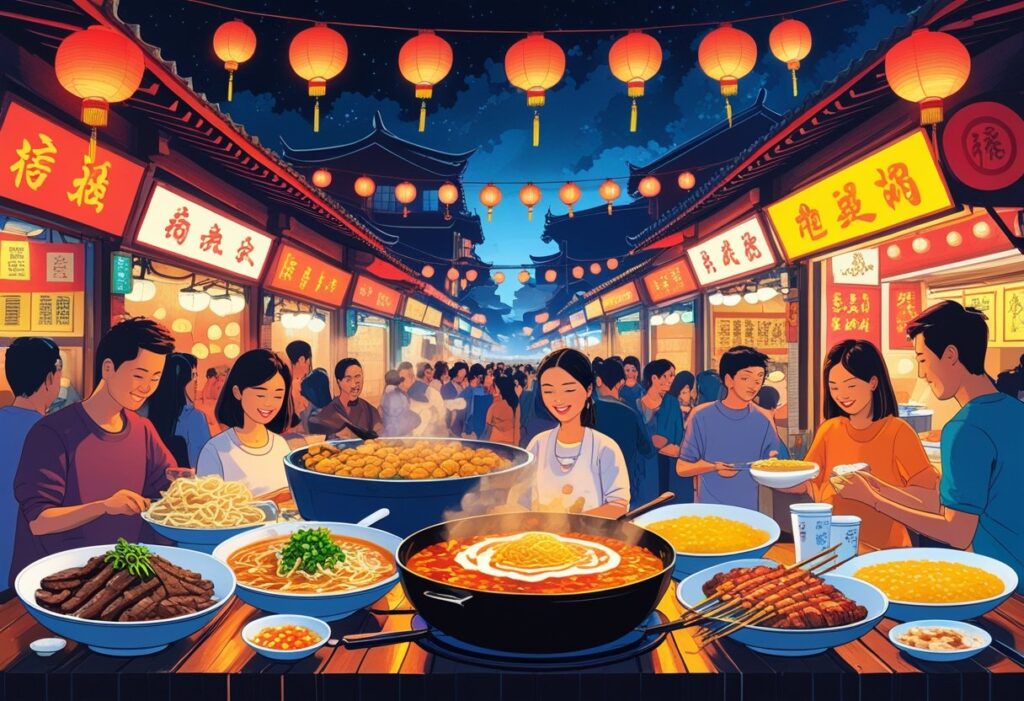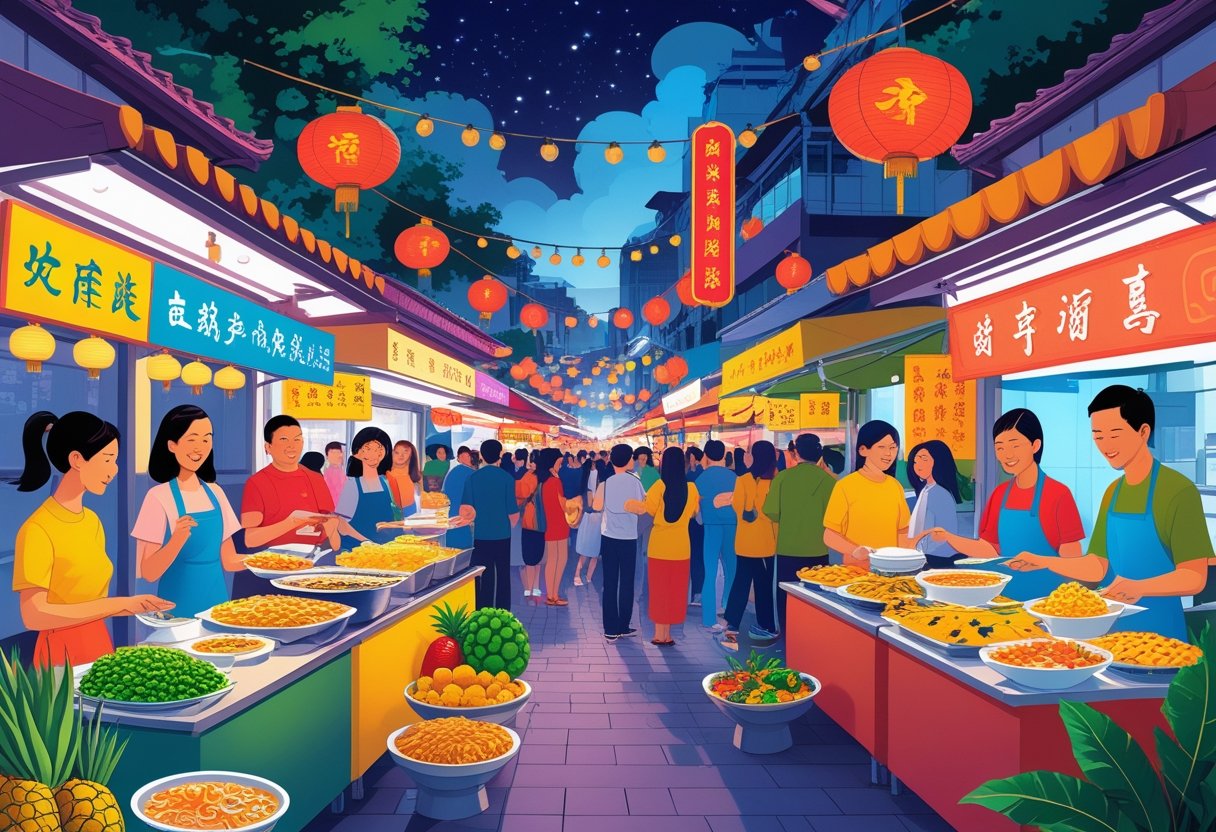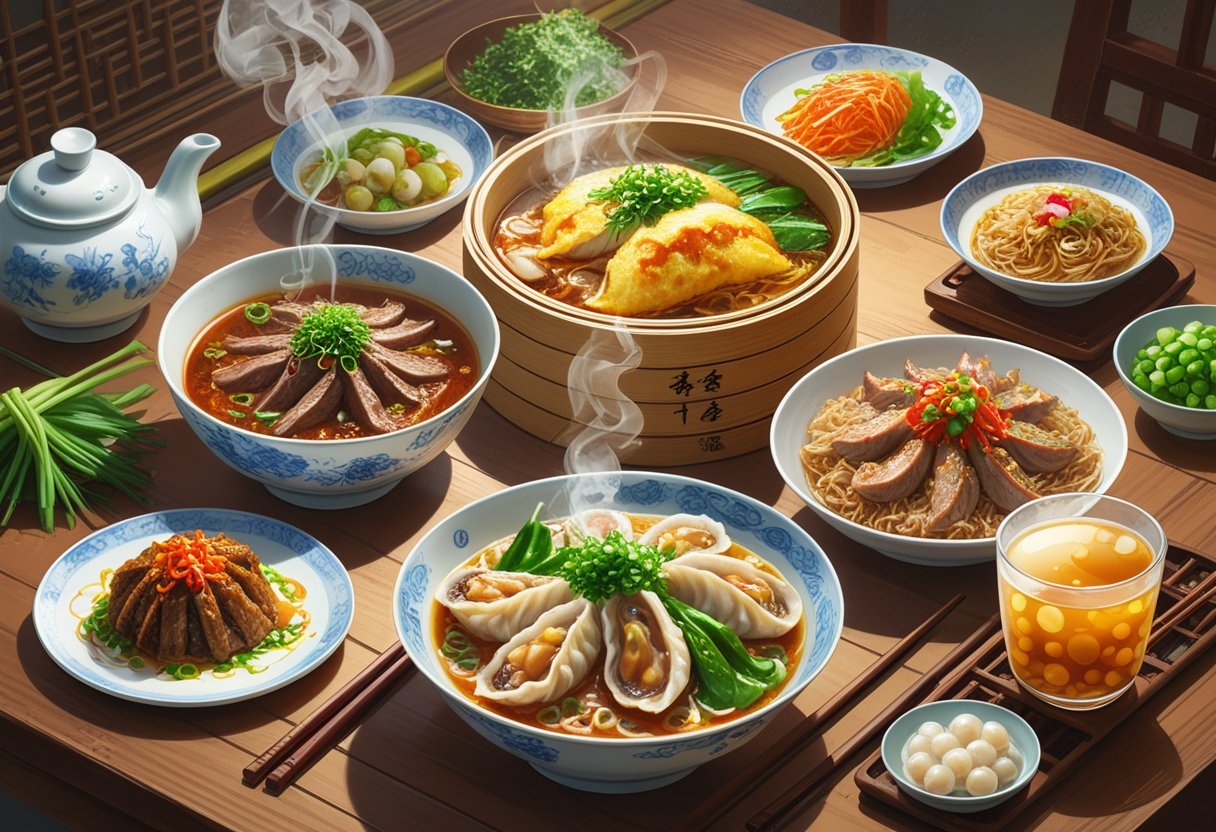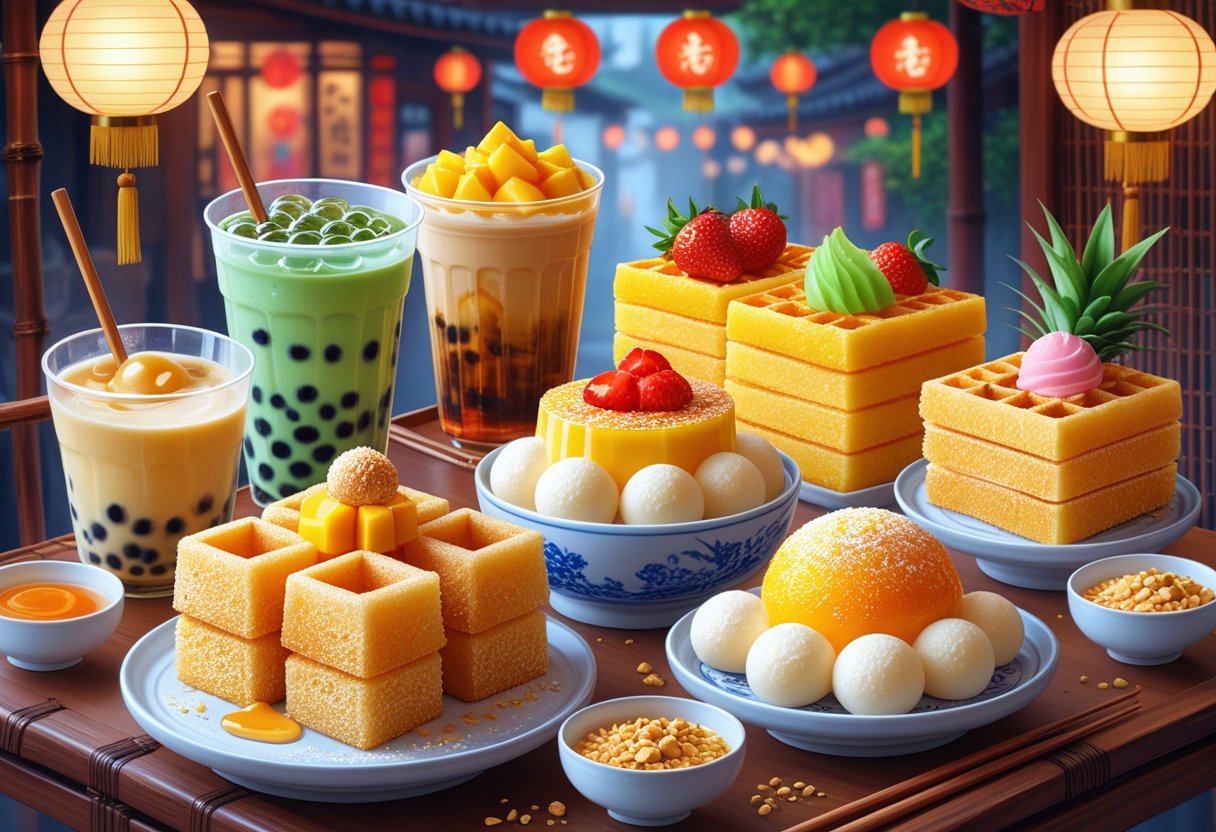Local food in Taiwan blends indigenous traditions with Chinese culinary techniques, Japanese influences, and creative modern twists, creating a distinctive food scene that revolves around bustling night markets and street-side vendors. The island’s cuisine features everything from savory beef noodle soup and braised pork rice to sweet treats like pineapple cakes and the world-famous bubble tea, and teaching English in Taiwan will mean you can afford to eat out three times a day!

Taiwan’s food culture reflects its complex history through dishes that combine familiar Asian flavors with unique local ingredients and cooking methods. Street food dominates the culinary landscape, with night markets serving as the heart of Taiwanese dining culture where vendors serve everything from oyster omelets to towering fried chicken.
Visitors discover that Taiwanese food goes far beyond typical Chinese cuisine, offering specialized regional dishes, innovative desserts, and fresh seafood preparations that showcase the island’s coastal location. The food scene emphasizes accessibility and variety, making it easy for anyone to explore authentic flavors through small plates, quick bites, and casual dining experiences.
What Makes Local Food in Taiwan Unique?

Taiwan’s culinary landscape stands out through its remarkable fusion of Chinese, Japanese, and indigenous influences, creating distinctive flavors that rely on key ingredients like soy sauce, five-spice, and fresh basil. The island’s signature dishes showcase this cultural blend while maintaining their own unique character.
Blend of Cultures and Influences
Taiwanese cuisine represents a fascinating melting pot of cultural traditions. Chinese immigrants brought foundational cooking techniques and recipes that form the backbone of many dishes. The Japanese colonial period introduced ingredients and preparation methods that remain deeply embedded in Taiwan’s food culture today.
Japanese influences appear in everything from the popularity of ramen shops to the refined tea ceremony traditions. Many Taiwanese restaurants serve dishes like curry rice and various noodle preparations that show clear Japanese origins but with local adaptations.
Indigenous aboriginal communities contribute unique ingredients and cooking methods that emphasize natural flavors and seasonal ingredients. Their influence appears in the use of wild plants, traditional steaming techniques, and respect for ingredient authenticity.
Southeast Asian flavors have also found their way into modern Taiwanese kitchens. Thai and Vietnamese influences create spicy and sweet-sour flavor profiles that complement traditional preparations.
Essential Ingredients and Flavors
Taiwanese cooking relies on several key ingredients that create its distinctive taste profile. Soy sauce serves as a fundamental seasoning, appearing in braised dishes and marinades throughout the cuisine.
Five-spice powder adds complexity to many preparations, particularly in meat dishes and street food. Fresh basil leaves provide aromatic notes that distinguish Taiwanese preparations from other Asian cuisines.
Garlic appears frequently, often combined with chili to create the bold flavors found in night market snacks. Sweet elements balance savory components, creating the characteristic sweet-salty combinations that define many dishes.
Common flavor combinations include:
- Soy sauce with sugar in braised preparations
- Five-spice with garlic in fried items
- Chili with basil in stir-fries
- Vinegar with ginger as condiments
Signature Dishes That Define Taiwan
Several dishes represent the essence of Taiwanese cuisine and its unique character. Beef noodle soup stands as perhaps the most iconic dish, featuring rich broth and tender meat that showcases the island’s ability to elevate simple ingredients.
Braised pork rice demonstrates how Taiwanese cooks transform basic components into complex flavors. The dish combines seasoned pork with perfectly cooked rice, often garnished with pickled vegetables.
Taiwanese fried chicken, known as popcorn chicken, incorporates the signature blend of soy sauce, chili, five-spice, and basil that defines local flavors. Street vendors serve these bite-sized pieces with wooden sticks for easy eating.
Xiao long bao represents the technical skill of Taiwanese cooks. These soup dumplings contain both meat filling and savory broth within thin dough wrappers.
Stinky tofu exemplifies Taiwan’s willingness to embrace bold, polarizing flavors. This fermented preparation can be fried, braised, or served in soup form with various accompanying sauces.
Taiwanese Street Food Culture

Taiwan’s street food scene represents one of the world’s most vibrant culinary landscapes, where traditional recipes meet modern innovation in bustling night markets. The culture revolves around accessibility, community gathering, and bold flavors that reflect the island’s diverse cultural influences.
Night Market Experience
Night markets form the heartbeat of Taiwanese street food culture. These bustling venues come alive after sunset, transforming ordinary streets into food wonderlands.
Visitors navigate crowded aisles filled with sizzling woks and steaming bamboo baskets. The atmosphere buzzes with conversations in multiple languages while vendors call out their specialties.
Most night markets operate from late afternoon until midnight. Popular markets like Shilin attract both locals grabbing dinner and tourists seeking authentic experiences.
The communal dining experience encourages sharing tables with strangers. Plastic stools and folding tables create impromptu dining areas where people bond over shared meals.
Popular Street Foods
Savory Classics:
- Xiao Long Bao – Soup dumplings with pork filling
- Stinky Tofu – Fermented tofu with pickled cabbage
- Oyster Omelet – Eggs mixed with fresh oysters and starch
- Beef Noodle Soup – Rich broth with tender beef chunks
Sweet Treats:
- Bubble Tea – Taiwan’s most famous export with chewy tapioca pearls
- Pineapple Cake – Buttery pastries with sweet pineapple filling
- Shaved Ice – Flavored ice topped with fruits and condensed milk
Street vendors often specialize in single dishes perfected over generations. Many operate from the same locations for decades, building loyal customer bases.
Iconic Taiwanese Snacks
Ba-wan stands as Taiwan’s unofficial national dish. These translucent dumplings contain pork, bamboo shoots, and mushrooms wrapped in a chewy sweet potato starch skin.
Gua bao, known as Taiwanese hamburgers, feature braised pork belly in steamed buns. Vendors top them with pickled mustard greens, crushed peanuts, and cilantro.
Scallion pancakes offer crispy, layered textures with fresh green onions. Cooks roll the dough multiple times to create distinct layers before pan-frying.
Dan zai noodles originated in Tainan and feature small portions of noodles in light broth. The dish traditionally included whatever ingredients were available that day.
Raohe Night Market
Raohe Night Market stretches along a single street in Taipei’s Songshan District. This compact market concentrates some of Taiwan’s best street food in an easy-to-navigate format.
The market opens at 5 PM and reaches peak energy around 8 PM. Weekends see longer lines and more crowded conditions.
Must-try vendors:
- Fuzhou black pepper buns at the market entrance
- Medicinal herb soup for traditional remedies
- Fresh fruit smoothies and sugar cane juice
Raohe specializes in traditional Taiwanese snacks rather than fusion cuisine. The market maintains authentic cooking methods and family recipes passed down through generations.
The narrow street layout creates an intimate atmosphere. Visitors can watch food preparation up close and interact directly with vendors who often speak basic English.
Must-Try Savory Dishes in Taiwan

Taiwan’s savory cuisine showcases rich broths, tender braised meats, fresh seafood preparations, and bold fermented flavors that define the island’s culinary identity.
Beef Noodle Soup
Beef noodle soup stands as Taiwan’s unofficial national dish. The rich, aromatic broth combines star anise, soy sauce, and secret spice blends that each vendor guards carefully.
Slow-cooked beef creates tender chunks that fall apart easily. The noodles maintain a perfect chewy texture that locals call “Q.”
Two main styles dominate Taiwan’s beef noodle scene:
- Red-braised: Spicy, tomato-based broth with bold flavors
- Clear broth: Lighter, herb-infused version with subtle tastes
Popular restaurants like Lin Dong Fang and Yong Kang serve bowls that draw long lines daily. Many establishments offer braised pork belly as an alternative protein.
The dish represents comfort food at its finest. Visitors often rank it among the best food in Taiwan.
Lu Rou Fan (Braised Pork Rice)
Lu rou fan delivers Taiwan’s soul food in a simple bowl. Minced pork simmers slowly in soy sauce, sugar, and spices until it reaches perfect tenderness.
The braised pork creates a glossy, caramelized sauce that coats every grain of steamed white rice. Vendors often add braised pork belly pieces for extra richness.
Traditional toppings include:
- Pickled mustard greens
- Green onions
- Braised eggs
- Preserved radish
Pork rice appears at breakfast stalls, night markets, and dedicated shops throughout Taiwan. The dish costs less than most meals while providing satisfying flavors.
Each region claims the best version. Southern Taiwan typically uses larger pork pieces, while northern vendors prefer finer minced pork.
Oyster Omelette
The oyster omelette combines fresh seafood with eggs and sweet potato starch. Pan-frying creates a unique texture that’s simultaneously crispy and chewy.
Plump oysters from Taiwan’s coastal waters provide briny sweetness. The starch creates a translucent, gelatinous coating around each oyster.
Vendors top finished oyster omelets with:
- Sweet chili sauce
- Cilantro
- Bean sprouts
- Lettuce
Night markets across Taiwan serve this iconic street food. The dish showcases Taiwan’s abundant coastal seafood resources.
Some vendors substitute clams or other shellfish when oysters aren’t available. The cooking technique remains consistent regardless of the seafood choice.
Stinky Tofu
Stinky tofu challenges visitors with its pungent aroma but rewards the brave with incredible flavors. Fermented tofu develops its distinctive smell through weeks of bacterial fermentation.
Deep-frying transforms the soft fermented tofu into crispy golden cubes. The exterior crunches while the interior remains creamy and custard-like.
Fried tofu vendors serve it with pickled cabbage and spicy sauce. The fermentation process creates complex umami flavors that complement the strong smell.
Two preparation styles exist:
- Deep-fried: Crispy exterior with soft center
- Steamed: Softer texture with more intense fermented flavors
Many night markets feature stinky tofu alongside pig’s blood cake and other adventurous foods. The dish represents Taiwan’s embrace of bold, challenging flavors.
First-time tasters should breathe through their mouths to minimize the initial shock.
Dumplings, Buns, and Pancakes

Taiwan’s dumpling and bread culture showcases incredible diversity, from soup-filled xiao long bao to fluffy steamed buns and crispy scallion pancakes. These flour-based dishes represent both traditional Chinese influences and uniquely Taiwanese innovations.
Xiao Long Bao
Xiao long bao are thin flour dumplings filled with pork meatball and gelatinized meat stock that melts into soup broth when steamed. Though originally from Shanghai, they’ve become one of Taiwan’s most beloved dishes.
Din Tai Fung in Taipei teaches the proper eating technique on instruction cards. The method involves adding soy sauce, vinegar, and ginger to a spoon, then transferring the dumpling on top.
Diners poke a hole in the side to release steam and let soup fill the spoon. The entire contents go in the mouth at once, though slurping the soup first prevents burns.
These delicate dumplings are steamed in small bamboo baskets. The thin wrapper holds the rich, flavorful broth that bursts when bitten.
Taiwanese Dumplings
Beyond xiao long bao, Taiwan offers various dumpling styles that reflect the island’s culinary diversity. Ba-wan are large, translucent meatball dumplings with a chewy texture made from sweet potato starch.
Pan-fried buns (sheng jian bao) feature crispy bottoms and soft tops. These dumplings are first steamed, then pan-fried until golden brown on the bottom.
Traditional steamed dumplings come with diverse fillings including pork, vegetables, and seafood. Night markets sell these affordable options alongside more elaborate varieties.
Zongzi are sticky rice dumplings wrapped in bamboo leaves. They contain sweet or savory fillings like red bean paste, pork, or chicken, representing authentic Taiwanese cuisine.
Bao and Gua Bao
Gua bao, often called “Taiwanese hamburgers,” consist of soft steamed buns filled with braised pork belly, pickled mustard greens, peanut powder, and coriander. These popular snacks have gained international recognition.
Lan Jia Gua Bao in Gongguan serves award-winning versions in plastic bags to prevent ingredients from falling out. The fluffy white bun contrasts perfectly with the rich, fatty pork filling.
Regular steamed buns (baozi) come with various fillings and represent everyday comfort food. They’re available at breakfast shops, convenience stores, and street vendors throughout Taiwan.
The soft, pillowy texture of properly made bao comes from careful fermentation and steaming techniques. Quality versions have light, airy interiors that absorb flavors from fillings.
Scallion Pancake
Scallion pancakes are flaky, chewy flatbreads cooked on griddles and filled with ingredients like Taiwanese basil, egg, ham, or cheese. They’re served with thick soy sauce or hot sauce.
Taipei Tian Jin Scallion Pancakes on Yongkang Street draws long queues of locals. The pancakes achieve perfect texture through layered dough techniques and precise cooking temperatures.
Hsiung Chi Scallion Pancake at Gongguan Night Market earned inclusion in the 2025 Michelin Bib Gourmand guide. This recognition creates lengthy lines that loop around the stall.
Some vendors prepare variations using rolled and deep-fried dough smeared with scallion combinations. These crispy alternatives offer different textures while maintaining the essential onion flavor profile.
Delightful Taiwanese Sweets and Desserts

Taiwan’s dessert scene blends traditional Chinese influences with Japanese techniques and local innovation. These treats range from buttery pastries filled with tropical fruit jam to refreshing ice desserts topped with chewy taro balls.
Pineapple Cake
Pineapple cake stands as Taiwan’s most iconic dessert souvenir. These buttery pastries feature a crumbly exterior filled with sweet pineapple jam.
The dessert holds special cultural significance beyond its taste. In Taiwanese Hokkien, pineapple translates to “ong lai,” which sounds similar to “incoming fortune.”
Traditional preparation includes:
- Butter and flour pastry shell
- Concentrated pineapple jam filling
- Square or rectangular shapes
- Individual wrapping for gifting
Taichung’s Miyahara shop has gained fame for their premium versions. They package the cakes in elegant boxes that make perfect gifts for visitors returning home.
The texture combines a tender, crumbly exterior with sweet, slightly tangy filling. Many bakeries now offer variations with different fruit fillings or nuts mixed into the jam.
Shaved Ice
Shaved ice, known locally as bao bing, ranks among Taiwan’s most popular cooling desserts. The ice gets shaved into fine ribbons rather than chunky flakes.
Mango bao bing represents the most beloved variety. Fresh mango chunks top the sweetened shaved ice along with condensed milk and sometimes ice cream.
Common toppings include:
- Seasonal fresh fruits
- Azuki beans
- Sweet potato chunks
- Aiyu jelly
- Grass jelly
- Tapioca pearls
The dessert shops throughout Taiwan serve countless variations. Some versions feature multiple fruit types while others focus on bean-based toppings.
The texture contrast makes each spoonful interesting. Soft ribbons of ice melt on the tongue while chewy jellies and beans provide substance.
Taro Balls and Mochi
Taro balls deliver the signature “QQ” texture that Taiwanese people crave. This chewy, bouncy quality comes from glutinous rice flour and starch.
These colorful spheres combine taro, sweet potato, and sometimes green tea flavors. Jiufen’s mountain town has become famous for serving authentic versions of this dessert.
Mochi offers another chewy experience with Japanese origins. Taiwanese versions often get stuffed with bean paste and rolled in peanut powder.
Serving styles vary:
- Hot soup with kidney beans
- Cold dessert bowls
- Grilled and dusted with powder
- Mixed with multiple flavors
Night markets frequently serve these treats on skewers. The grilled mochi gets heated until slightly crispy outside while remaining soft inside.
Both desserts showcase Taiwan’s love for textural variety. The bouncy consistency requires proper chewing and creates a satisfying eating experience.
Peanut Ice Cream Roll
Peanut ice cream roll combines traditional and modern elements in one unique dessert. Vendors shave thin layers from blocks of peanut candy using special planes.
The process creates delicate peanut shavings that get wrapped around scoops of ice cream. Popular ice cream flavors include taro, vanilla, and seasonal fruit varieties.
Assembly process:
- Shave peanut candy into thin curls
- Place ice cream scoop in center
- Wrap peanut shavings around ice cream
- Add cilantro leaves (traditional garnish)
- Serve immediately in paper wrapper
The cilantro addition surprises many first-time visitors. This herb provides a fresh contrast to the rich peanut and creamy ice cream combination.
Street vendors prepare each roll fresh to order. The peanut candy stays at room temperature while the ice cream remains frozen, creating temperature contrast in each bite.
The Bubble Tea Phenomenon
Taiwan’s most famous beverage export started in the 1980s and has since conquered taste buds worldwide. The drink combines tea with chewy tapioca pearls and countless flavor variations that define modern Taiwanese café culture.
History of Bubble Tea
Bubble tea originated in Taiwan during the early 1980s, though its exact creation story remains debated. One account credits Lin Hsiu Hui at Chun Shui Tang teahouse in Taichung, who added sweetened tapioca balls to iced tea during a meeting.
Another story points to Tu Tsong-he at Hanlin Tea Room in Tainan, who created “pearl tea” using white tapioca balls. Both versions highlight how this accidental innovation became Taiwan’s signature drink.
The beverage quickly spread across Taiwan as teahouses experimented with different flavors and ingredients. By the 1990s, Taiwanese immigrants brought bubble tea to international markets, starting with East Asian countries and California’s Taiwanese communities.
Major cities like New York, Los Angeles, and Toronto saw bubble tea shops emerge in the early 2000s. Brands like Chatime, Gong Cha, and Kung Fu Tea eventually expanded the global reach from Taiwan to Hong Kong, mainland China, the United States, and Indonesia.
Tapioca Pearls and Toppings
Tapioca pearls form the heart of authentic bubble tea, creating the distinctive texture that sets it apart from regular beverages. These chewy spheres, made from cassava starch, are cooked until they achieve the perfect QQ texture – a Taiwanese term describing their bouncy, chewy consistency.
Traditional black tapioca pearls remain the most popular option, typically sweetened with brown sugar or honey. White pearls offer a milder flavor profile and softer texture.
Modern bubble tea shops offer extensive topping varieties:
- Popping boba – fruit-flavored spheres that burst with juice
- Fruit jellies – coconut, lychee, and mango varieties
- Puddings – egg, taro, and chocolate options
- Red beans and grass jelly for traditional flavors
The wide straws used for bubble tea serve a functional purpose, allowing the pearls and toppings to pass through easily. Drinking becomes a unique experience of simultaneously eating and sipping.
Must-Try Bubble Tea Variations
Classic milk tea with tapioca pearls represents the original bubble tea experience. This combination uses black tea, milk, and sweetened pearls for the foundational flavor profile that launched the global phenomenon.
Taro bubble tea showcases Taiwan’s love for this purple root vegetable. The creamy, nutty flavor creates a distinctive lavender-colored drink that’s become increasingly popular worldwide.
Brown sugar milk tea gained massive popularity in recent years, featuring caramelized brown sugar syrup that creates striking visual layers. The syrup coats the cup’s sides, creating Instagram-worthy presentations.
Fruit-based variations include passion fruit, mango, and lychee options. These lighter alternatives often use green tea bases and fresh fruit pieces instead of milk.
Winter melon tea offers a refreshing, subtly sweet option that’s particularly popular during hot weather. Matcha bubble tea combines Japanese green tea powder with the Taiwanese pearl tradition, creating cross-cultural fusion drinks.
Seafood and Fresh Ingredients
Taiwan’s coastal location provides abundant access to fresh seafood that defines much of the island’s cuisine. The seafood scene ranges from bustling fish markets to specialized restaurants where diners select live catches from tanks.
Popular Seafood Dishes
Oyster omelette stands as one of Taiwan’s most beloved seafood dishes. The dish combines fresh oysters with eggs and sweet potato starch to create a chewy, flavorful experience.
Grilled squid appears frequently at night markets across the island. Vendors prepare it with various seasonings and serve it hot off the grill.
Steamed whole fish represents traditional Taiwanese cooking methods. Restaurants often steam fish with ginger, scallions, and soy sauce to preserve the natural flavors.
Seafood hot pot allows diners to cook various fresh catches including shrimp, clams, and fish in flavorful broths. Many establishments let customers choose their seafood from display tanks.
Regional Seafood Specialties
Tainan earned recognition as Taiwan’s snack city, particularly for its exceptional oyster omelettes. The coastal city’s location ensures a constant supply of fresh oysters from nearby waters.
Taipei and Kaohsiung feature numerous seafood restaurants where diners select their meals from large tanks. The Addiction Aquatic Development market in Taipei offers extensive fresh seafood selections.
Coastal towns throughout Taiwan specialize in locally caught fish and shellfish. Each region develops its own preparation methods based on available catches and local preferences.
Many restaurants follow the tank-to-table concept, displaying live seafood for customers to choose before preparation.
Experiencing Food When Visiting Taiwan
Taiwan’s vibrant food culture thrives in night markets and local neighborhood restaurants where travelers can sample authentic dishes alongside locals. Understanding basic dining customs and knowing where to find the best eats enhances the culinary adventure.
Best Places to Eat
Night markets serve as Taiwan’s primary food destinations. These bustling venues offer everything from xiaolongbao to stinky tofu at affordable prices. Shilin Night Market and Ningxia Night Market in Taipei feature diverse options with dishes ranging from 20-300 TWD per person.
Local neighborhood restaurants provide authentic experiences away from tourist crowds. Small family-run establishments often serve the most traditional preparations of beef noodle soup and three cup chicken.
Street vendors throughout cities like Taipei and Kaohsiung offer quick bites. Travelers can find scallion pancakes for around 50 NTD and oyster omelets for approximately 40 NTD.
Traditional tea houses like Chun Shui Tang offer bubble tea alongside noodle dishes. These establishments typically cost more than street vendors but provide sit-down dining experiences.
The basement food courts of major buildings, including Taipei 101, house renowned restaurants like Din Tai Fung. These locations offer climate-controlled dining with international recognition.
Local Etiquette and Tips
Standing while eating is common at many popular spots. Establishments like Ay-Chung Flour-Rice Noodle provide no seating, expecting customers to enjoy their intestine noodles standing up.
Peak hours create long waits at famous restaurants. Visiting between 9-10 AM or mid-afternoon helps avoid crowds. Some restaurants limit dining time to 90 minutes during busy periods.
Cash payments remain standard at most street vendors and night markets. Travelers should carry small bills for easier transactions.
Cleaning up after eating shows respect, especially at market stalls and casual dining areas. Most venues provide designated trash areas for proper disposal.
Language barriers rarely affect food ordering since many vendors use picture menus or display cases. Pointing and gesturing work effectively for communication.
Sharing dishes aligns with local dining culture, particularly at hot pot restaurants where multiple broths and ingredients create communal meals.


